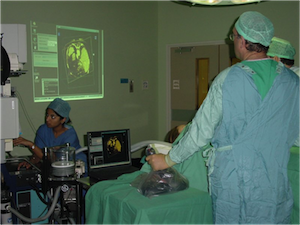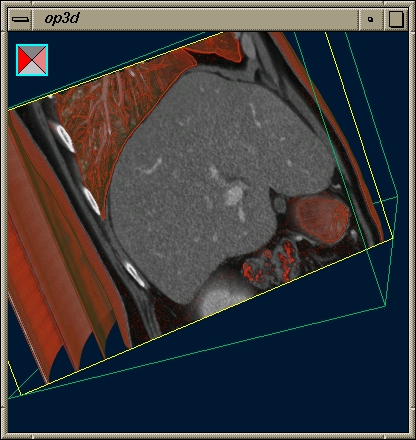Professor Nigel W. John FEG FLSW
Home Research About Contact
3D Volume Visualization in the Operating Room (2000-3)

 Example volume rendering of patient data.
This project was carried out at the Manchester Visualization Centre in collaboration with Rory McCloy, a consultant hepato-pancreatic surgeon at the Manchester Royal Infirmary. We developed a novel method of delivering real time volume visualisations of patient data to the operating theatre in a manner that allows effective interaction and interpretation of the 3D data (John, Mccloy, & Herrman, 2004). Previously, the surgeon was faced with x-ray hard copy films displayed on a light box and had to rely on his visual-cerebral capabilities to translate the image ‘slices’ into 3D anatomy and memorise them as he/she turns to the operating table. This basic display environment can be a limiting factor in the chances of curative surgery as tumour deposits are missed and/or left behind at the time of surgical resection. The new visualisation system has revolutionised the surgeon’s working environment, however, and has been used at the Manchester Royal Infirmary throughout 2002 to assist in hepato-pancreatic surgery.
Example volume rendering of patient data.
This project was carried out at the Manchester Visualization Centre in collaboration with Rory McCloy, a consultant hepato-pancreatic surgeon at the Manchester Royal Infirmary. We developed a novel method of delivering real time volume visualisations of patient data to the operating theatre in a manner that allows effective interaction and interpretation of the 3D data (John, Mccloy, & Herrman, 2004). Previously, the surgeon was faced with x-ray hard copy films displayed on a light box and had to rely on his visual-cerebral capabilities to translate the image ‘slices’ into 3D anatomy and memorise them as he/she turns to the operating table. This basic display environment can be a limiting factor in the chances of curative surgery as tumour deposits are missed and/or left behind at the time of surgical resection. The new visualisation system has revolutionised the surgeon’s working environment, however, and has been used at the Manchester Royal Infirmary throughout 2002 to assist in hepato-pancreatic surgery.
We used an SGI Origin 2000 server with InfiniteReality2 graphics pipelines at MVC to provide large scale visualization of medical data, and OpenGL Vizserver to send real-time graphics to a laptop client in the operating room - one mile away at the hospital.
SGI nominated this work for the 2003 Computerworld Honors Program. We made the finals of the Medicine category and attended a gala evening at the National Building Museum in Washington D.C. (June 2nd, 2003). The project was also covered by Nature Online, the BBC News, the Tomorrow’s World programme, the Discovery Channel and the National Geographic cable channel.
Further Reading
- John, N. W., Mccloy, R. F., & Herrman, S. (2004). Interrogation of patient data delivered to the operating theatre during hepato-pancreatic surgery using high-performance computing. Computer Aided Surgery, 9(6), 235–242.